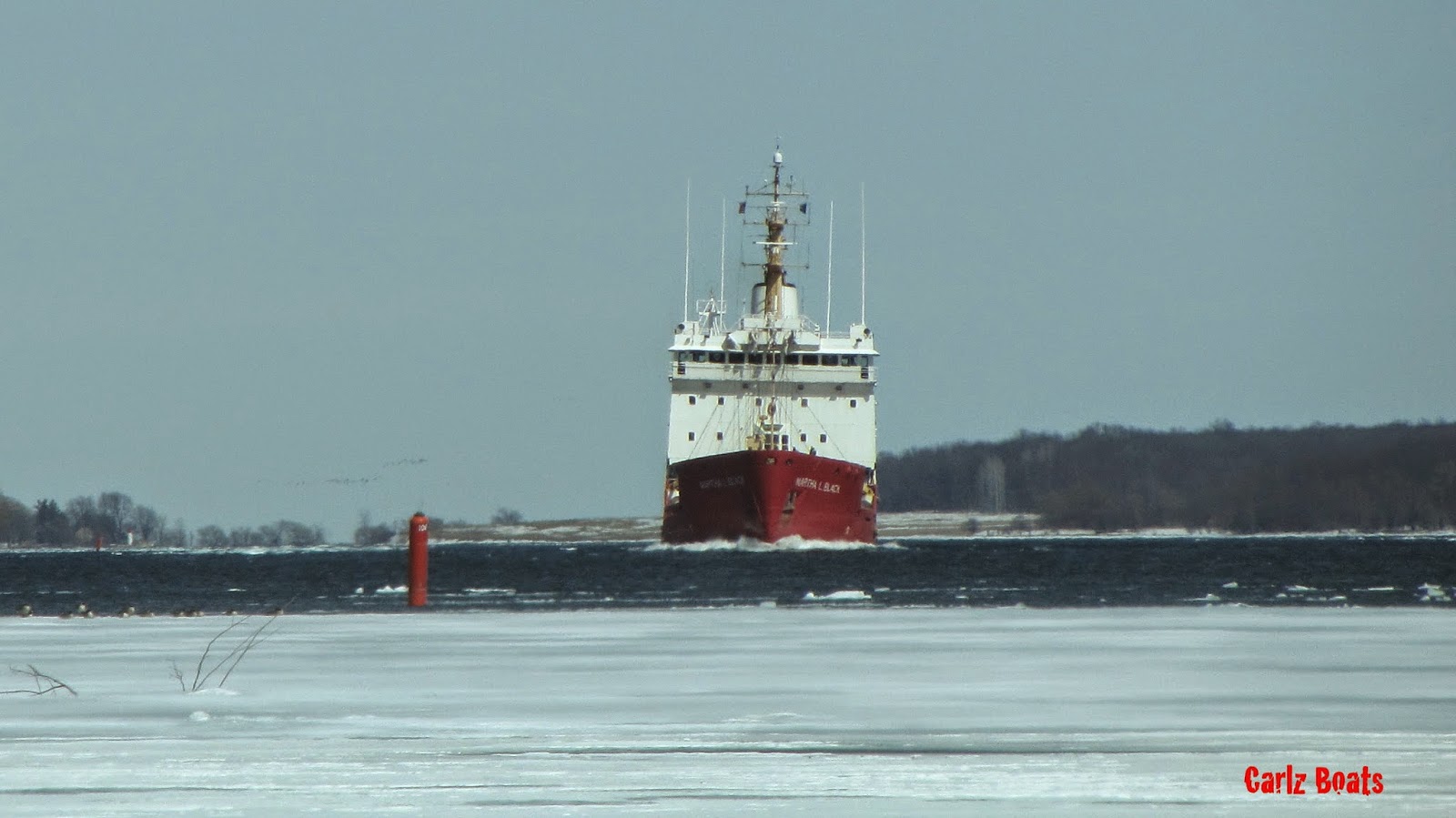 |
| Crane barge & SHANE C pushes by tanker barge & LORI JOHNSON just beyond the twin span Crescent City Connection Bridge. |
 |
| Old Glory sailpast. |
NOLA, a.k.a. "New Orleans, Louisiana", "The Big Easy", "The Crescent City", and due to the carefree and easy-going nature of so many who live there, it's also been tagged "The City That Care Forgot". Like most days this winter that started with an outside temperature of -25C which actually felt like -36C in the wind, a return to the southern comfort and hospitality we received when visiting New Orleans last May, could be just what the doctor ordered for anyone living north of the Great Lakes regions suffering from the ongoing "When's it gonna end" winter blahs. However, a nickname that might be added to the books is "The City with the River That Never Stops". No, I'm not talking about the lazy Mississippi that saunters along almost motionless at 3 miles per hour day in and day out but instead the constant ship movement of bulk carriers, container ships, tankers, cruise ships, harbour tugs, ferries, replica paddle wheelers like the
NATCHEZ and
CREOLE (snapped up above), but most importantly, barges and their towboats.
NOLA is home to the 6th largest port in the United States and has the longest wharf in the world, over 2 miles long which can accommodate 15 salties at once. The port also handles over 50,000 barges annually carrying just about anything from corn to wheat, oil seeds and grain products to stone, coal and oil products.
Most of the barges we saw from along NOLA's waterfront park or when cruising along the Mississippi on the steam paddle-wheeler
NATCHEZ, were powered by square bowed towboats with steel knees designed for pushing like the 79'
LOUISIANAN (above) owned by Hagman Marine of Houston, Texas. Here's some more boats & barges:
 |
| Downbound 69' SAFETY PRIORITY pushing a tanker barge both owned by AEP River Operations. |
 |
| Downbound 72' STEPHANIE STONE by John W. Stone Oil Distributors pushes a tanker barge. |
 |
| Built in 2011 is the 70' and 1330 hp ERIC BUNCE pushing the 10,000 barrel clean chemical barge WEB 126. Both owned by Blessey Marine Services of Harahan, LA. |
 |
| Motoring along upbound is the Kirby Inland Marine owned 130.5' CITY OF REDWOOD pushing black oil tankers KIRBY 28185 & 28183. |
 |
| GO NAVY!! |
 |
| When launched in 1974 in Carlyss, LA, this twin screw and 3800 horsepower towboat was named W.F. FREDEMAN JR. In 1995 she was renamed CITY OF REDWOOD when purchased by Kirby Inland Marine of Houston, TX |
 |
| Group of coal laden hoppers wait to be midstream loaded into a deep sea bulk carrier further downsteam. That story and snaps to be featured soon in Carlz Boats. I know you can hardly wait, eh! c):-b |
 |
| Towboats and barges waiting to dock space. |
 |
| Empty hoppers waiting to take on cargo. |
 |
| Loaded hoppers waiting to go ANYWHERE!!. |
A non-squared bow towboat that we saw during our
NATCHEZ cruise was the 100' Patapsco-class tug
WYR RIVER parked along her also Vane Brothers owned tanker barge,
DOUBLE SKIN 53. The 362.5'
53 was built in 2006 with 2 hulls, which prevents leakage of any of its 50,000 barrels of heavy oil and another potential environmental disaster if the barge struck an object below the waterline like the super tanker
EXXON VALDEZ did off the coast of Alaska in 1989. Another Vane Brothers tandem featured in Carlz Boats was the towboat
ROANOKE and the slightly small tanker barges
DOUBLE SKIN 214 & 216. My friend Jim snapped them along the Wicomico River in Salsbury, Maryland. Feel free to check out that post:
http://carlzboats.blogspot.ca/2013/07/tanker-barge-double-skin-214-pushboat.html
 |
| Dock up ahead not ready just yet? No Problem!! Just nudge your payload into the Mississippi silt and then tie her off to a tree. Worked for the 78' JUSTIN D. SBISA and her chemical barge FMT 3026. c):-)) |
No doubt about it, the Mississippi River is a critical artery for the United States carrying over 2 billion bushels of grain and 20% of America's coal and petroleum products yearly downstream to river ports like NOLA destined to world markets. The fact is, it would take 16 rail cars or 70 trucks to carry a normal barge load of dry cargo and 46 rail cars or 144 truck to transport a normal barge load of liquid cargo. Regardless of size or type, river barges and their towboats are needed especially this unknown re-fueler below laden with bunker to keep commerce moving along the "River that Never Stops". C);-b
BTW: Happy 46th Anniversary to my good friend Jim and his wife Dawn of Salisbury, Maryland who have been escaping from winter in Fort Myers, Florida since before Christmas. As my grandson Hayden would say, "Lucky Ducks!!" (:()
Meanwhile, everyone else who's tired of of winter and waiting for the snow to melt, check out these previous NOLA posts about the steam paddle-wheeler
NATCHEZ http://carlzboats.blogspot.ca/2014/05/steamboat-natchez_15.html and those two big grey hulks down river in the background, the
CAPE KENNEDY & CAPE KNOX http://carlzboats.blogspot.ca/2014/08/roro-carriers-cape-kennedy-cape-knox.html.



















































